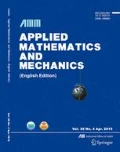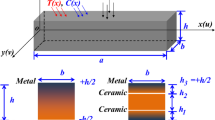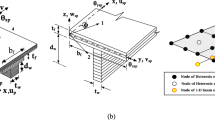Abstract
Based on the elongated Kelvin model, a simplified periodic structural cell is obtained to investigate the tensile behavior of anisotropic open-cell elastic foams due to Kelvin model’s periodicity and symmetry in the whole space. The half-strut element and elastic deflection theory are used to analyze the tensile response as done in the previous studies. This study produces theoretical expressions for the tensile stress-strain curve in the rise and transverse directions. In addition, the theoretical results are examined with finite element simulation using an existing formula. The results indicate that the theoretical analysis agrees with the finite element simulation when the strain is not too high, and the present model is better. At the same time, the anisotropy ratio has a significant effect on the mechanical properties of foams. As the anisotropy ratio increases, the tensile stress is improved in the rising direction but drops in the transverse direction under the same strain.
Similar content being viewed by others
References
Gong, L., Kyriakides, S., and Jang, W. Y. Compressive response of open-cell foams, part I: morphology and elastic properties. International Journal of Solids and Structures, 42, 1355–1379 (2005)
Jang, W. Y., Kraynik, A. M., and Kyriakides, S. On the microstructure of open-cell foams and its effect on elastic properties. International Journal of Solids and Structures, 45, 1845–1875 (2008)
Perrot, C., Panneton, R., and Olny, X. Periodic unit cell reconstruction of porous media: application to open-cell aluminum foams. Journal of Applied Physics, 101, 113538 (2007)
Lu, Z., Wang, R., and Huang, Z. A review of studies on the mechanical properties of foam plastics. Advances in Mechanics, 26(3), 306–323 (1996)
Gibson, L. J. and Ashby, M. F. Cellular Solids: Structure & Properties, Pergamon Press, Oxford (1997)
Lu, Z. and Tian, C. Modification of anisotropic model for foam plastics. Chinese Journal of Applied Mechanics, 13(4), 108–111 (1996)
Lu, Z., Zhang, J., and Wang, S. Investigation into elastic properties of anisotropic random foam model. Journal of Beijing University of Aeronautics and Astronautics, 32(12), 1468–1471 (2006)
Lu, Z., Chen, X., and Zhang, J. Numerical modeling of high strain compression of anisotropic elastic open-cell foams. Journal of Beijing University of Aeronautics and Astronautics, 34(5), 564–567 (2008)
Lu, Z., Huang, J., and Chen, X. Elastic properties of anisotropic Kelvin model for open-cell foams. Acta Aeronautica et Astronautica Sinica, 30(6), 1017–1022 (2009)
Lu, Z., Huang, J., and Chen, X. Analysis and simulation of high strain compression of anisotropic open-cell elastic foams. Science China Technological Sciences, 53(3), 863–869 (2009)
Gong, L. and Kyriakides, S. Compressive response of open cell foams, part II: initiation and evolution of crushing. International Journal of Solids and Structures, 42, 1381–1399 (2005)
Andrews, E. W. and Gibson, L. J. The influence of crack-like defects on the tensile strength of an open-cell aluminum foam. Scripta Materialia, 44, 1005–1010 (2001)
Kabir, M. E., Saha, M. C., and Jeelani, S. Tensile and fracture behavior of polymer foams. Materials Science and Engineering A, 429, 225–235 (2006)
Aly, M. S. Effect of pore size on the tensile behavior of open-cell Ti foams: experimental results. Materials Letters, 64, 935–937 (2010)
Aly, M. S. Tensile properties of open-cell nickel foams. Materials and Design, 31, 2237–2240 (2010)
Zhu, H. X., Mills, N. J., and Knott, J. F. Analysis of the high strain compression of open-cell. Journal of the Mechanics and Physics of Solid, 45(11–12), 1875–1904 (1997)
Shi, S. and Lu, Z. Finite element analysis for the elastic modulus of open-cell foams based on a tetrakaidecahedron model. Journal of Mechanical Strength, 28(1), 108–112 (2006)
Warren, W. E. and Kraynik, A. M. The nonlinear elastic behaviour of open-cell foams. Journal of Applied Mechanics, 58, 376–381 (1991)
Author information
Authors and Affiliations
Corresponding author
Additional information
Project supported by the National Natural Science Foundation of China (Nos. 11472025 and 11272030)
Rights and permissions
About this article
Cite this article
Lu, Zx., Liu, Q. & Chen, X. Analysis and simulation for tensile behavior of anisotropic open-cell elastic foams. Appl. Math. Mech.-Engl. Ed. 35, 1437–1446 (2014). https://doi.org/10.1007/s10483-014-1874-7
Received:
Revised:
Published:
Issue Date:
DOI: https://doi.org/10.1007/s10483-014-1874-7




